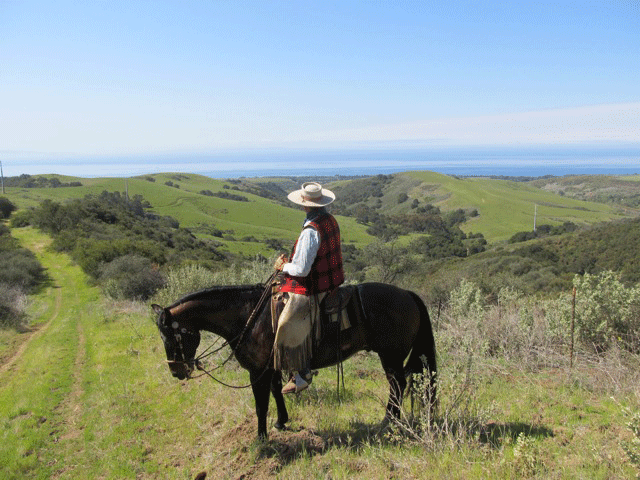What is an Early Californio Bridle Horse?
The Early Californio bridle horse is a ranch horse trained using the Californio (jaquima to freno) method of balance and timing to create a horse that is fluid in every movement with minimal input from the rider.
The Californio bridle horse is an all around good riding horse, cow horse and rope horse. He should be able to do these jobs while staying in perfect balance in any type of ground or terrain. It's a horse that is functional beauty personified.
"My ideal of what a true Californio bridle horse should feel like had always eluded me, until I let go of all my ideas of working off pressure points (the way I was taught though out my life) and adopted the idea of working off balance points."
The true Californio method, or at least what I believe it to be based on how every piece of equipment is built and how it works, is a balance-based method. The difference between a balanced based method and other systems, even great classical dressage, is other systems are based on pressure and release: the rider applies pressure and the horse yields to this pressure and is rewarded in the best scenario.
In the balanced based method the signal is when the rider moves his body and equipment slightly out of balance, without tension. The horse then yields by finding the balance and relief that is built into the equipment and the rider’s body. If ridden and taught correctly, the only time pressure is used would be when the horse is not paying attention to the balance change. This “pressure” becomes less necessary throughout the horse’s life and training, as does the amount of balance change needed to get the same result from the horse. Therefore, to compare this style to other styles of riding is difficult because it's so different than every other method I know of.
“I think that a true bridle horse does not just work to get a task done as there are many ways to do that. I think a true bridle horse does his job and also represents the beauty and art that is obtained through understanding and refined communication.”
The people who developed this system understood how a horse worked. They developed tools, when used properly, which would enhance the horse’s performance in a very intuitive manner for the horse. The biggest problem I find is what is intuitive and natural for the horse is often counter intuitive and unnatural to the human.
What is the difference between the classical Californio method and other methods?
For me, it is a refinement of communication. This whole method is built around protecting the mouth of the horse so communication can be acquired without pain or force, but through understanding and knowledge. The use of the two-rein with the spade bit allows me to relate to the horse when it is not following direction by making their actions harder or uncomfortable not painful. This method also allows me to have the greatest control of the horse’s entire body with the least amount of influence from me. This allows me to rope or work a cow without getting in the horses way, which in turn allows them to work better with less effort.
A lot of people seem to be intimidated by the whole early California style of riding. In reality it is just an almost lost art of being able to ride effectively and consistently with one hand, without splitting our reins away from the horses spine too much.
I think a bridle horse should not only be handy, they should also have a very graceful way of moving. They should carry themselves in collection without aid of the rein. When they are collected they will have the arch of neck so often described by the men of old. They should have a love of their work yet always remain supple to the rein. They should be trustworthy and brave and a pleasure to be around either mounted or on foot. A true bridle horse will always try and find the balance of the bit as well as the balance of the rider. When I judge a bridle horse I think of some of the qualities of a ballroom dancer while they float around the floor with intricate foot work and upper bodies are in frame: this is what I look for in the bridle horse’s top line. I also look for this in the rider. While their hips and legs may be doing quite a lot, their upper body is quiet and straight over the horse’s spine.
Everything I do for a colt sets him up for becoming a bridle horse someday.
I think that a true bridle horse does not just work to get a task done as there are many ways to do that. I think a true bridle horse does his job and also represents the beauty and art that is obtained through understanding and refined communication.
What is the difference between the classical Californio method and other methods?
What I have found over and over again, is the horses’ acceptance and understanding of the principles used in this system without having to be drilled or trained into them. Once the rider understands and learns to present the principles of this system consistently, the horse will respond to the smallest lightest signal the rider can send. This system is so intuitive to the horse, once the rider learns to work inside the system’s parameters, it changes the relationship with any horse they ride in a positive manner.


